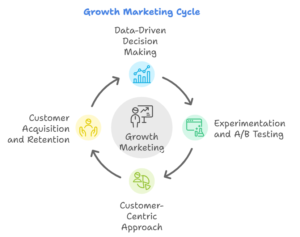Introduction to Growth Marketing
In today’s fast-paced digital world, growth marketing has emerged as a powerhouse strategy for businesses that want to scale effectively. Unlike traditional marketing, which typically focuses on short-term tactics like brand awareness and direct sales, growth marketing is a holistic, long-term approach. It focuses on sustainable growth by constantly experimenting, optimizing, and improving every step of the customer journey. But what exactly makes up a successful growth marketing strategy? Let’s dive into the essential components of growth marketing and explore how they work together to fuel business growth.
The Core Components of Growth Marketing
Data-Driven Decision Making
At the heart of growth marketing lies data-driven decision making. Gone are the days when gut feeling or intuition dictated marketing strategies. In growth marketing, every decision is informed by data. Whether it’s user behavior on your website, engagement metrics from your social media campaigns, or customer feedback, data offers insights that drive more precise and effective marketing strategies. Tools like Google Analytics, customer relationship management (CRM) platforms, and A/B testing software help marketers understand what works, what doesn’t, and where to pivot.
Understanding your audience’s behavior and preferences allows you to tailor your marketing efforts to meet their needs. This is why top-performing growth marketers always have their finger on the pulse of real-time data. Without data, you’re simply shooting in the dark.
Experimentation and A/B Testing
Experimentation is a vital pillar of growth marketing. The reason growth marketers succeed is because they are not afraid to test, fail, and test again. By using A/B testing, they can experiment with different marketing messages, creatives, landing pages, and offers to see what resonates best with the audience. It allows marketers to optimize campaigns based on real-world performance, eliminating guesswork from the equation.
A/B testing, in particular, helps determine which version of a marketing asset drives better results. For example, testing two different email subject lines can reveal which one gets more opens and clicks. Growth marketers understand that optimization is not a one-time effort but a continuous process that leads to incremental improvements over time. By regularly testing and iterating on their campaigns, they can maximize ROI and push growth boundaries.

Customer-Centric Approach
In growth marketing, the customer is at the center of everything. This customer-centric approach ensures that marketing strategies align closely with customer needs, behaviors, and feedback. By listening to customers, growth marketers can develop more relevant marketing campaigns that resonate deeply with their target audience. A customer-centric approach means understanding not only what your customers want but also why they want it.
Tools like surveys, feedback forms, and social media listening platforms are essential in gathering insights that can improve your offerings. Once you’ve identified your customers’ pain points and desires, you can create solutions that provide value, ensuring higher customer satisfaction and loyalty.
Customer Acquisition and Retention
A key goal of growth marketing is to strike the right balance between customer acquisition and retention. While attracting new customers is important, retaining existing ones is even more crucial for sustainable growth. Acquiring new customers is generally more expensive than retaining them, so growth marketers focus on developing retention strategies that keep customers engaged and loyal.
Growth marketing involves nurturing relationships through consistent communication, personalized offers, and customer support. By focusing on the entire customer lifecycle, from initial contact to long-term loyalty, marketers can maximize customer lifetime value (CLTV) and ensure ongoing revenue.
Multi-Channel Engagement
Leveraging Different Marketing Channels
Growth marketing doesn’t rely on just one or two marketing channels. Instead, it utilizes a multi-channel strategy that allows brands to reach customers wherever they are—whether it’s on social media, search engines, email, or paid ads. Each channel plays a unique role in engaging prospects and moving them down the sales funnel.
For instance, SEO helps attract potential customers searching for solutions online, while email marketing nurtures leads with personalized content. Paid ads offer immediate visibility, and social media provides a platform for brand storytelling and community building. By integrating these channels into a cohesive strategy, growth marketers ensure that no stone is left unturned in their pursuit of growth.
Personalization Across Channels
Personalization is the key to successful multi-channel engagement. In a world of information overload, customers expect personalized experiences across all touchpoints. Growth marketing uses data to deliver personalized content, offers, and messaging tailored to individual preferences.
Customer segmentation, powered by CRM systems and marketing automation tools, allows brands to create highly targeted campaigns that speak directly to specific customer segments. For example, a repeat customer might receive a different email than a first-time visitor, and someone who has abandoned a shopping cart might get a personalized reminder to complete their purchase. Personalization leads to higher engagement, conversions, and ultimately, customer satisfaction.
Customer Feedback and Iteration
Importance of Customer Feedback Loops
One of the most critical components of growth marketing is the feedback loop. Continuous improvement is impossible without understanding how customers feel about your products or services. Feedback loops allow growth marketers to gather insights directly from users, enabling them to adjust marketing strategies and improve offerings based on real customer experiences.
Growth marketers use various tools to collect feedback, such as Net Promoter Score (NPS) surveys, customer reviews, and social media listening. These insights help marketers understand pain points, discover new opportunities, and enhance customer satisfaction. By incorporating feedback into their strategies, companies can stay agile and responsive to market demands.
Iterative Campaign Optimization
Iteration is a fundamental practice in growth marketing. Instead of launching one-time campaigns and moving on, growth marketers consistently refine and optimize their marketing efforts based on performance data and customer feedback. This process of iteration ensures that each campaign is better than the last.
For example, a company might launch a paid ad campaign that performs moderately well. By analyzing data and making slight adjustments—such as changing the ad copy, targeting a different audience, or adjusting the budget—the next iteration of the campaign can achieve significantly better results. The key is to never settle and always strive for continuous improvement.
The Role of Product in Growth Marketing
Product-Market Fit
Achieving product-market fit is one of the most important milestones for any business, and growth marketing plays a pivotal role in getting there. Product-market fit occurs when your product satisfies a strong market demand, and growth marketing helps ensure that your product is positioned in front of the right audience. Without product-market fit, no amount of marketing can drive sustainable growth.
Once you’ve achieved product-market fit, your marketing strategy shifts from finding customers to scaling growth. This is where growth marketers begin to focus on expanding customer reach and retaining the users they’ve already acquired.
Using Product as a Growth Lever
In growth marketing, the product itself can serve as a marketing tool. By embedding features like referral programs or offering incentives for users to share the product with their network, businesses can drive organic growth. This is known as product-led growth. Companies like Dropbox and Slack have mastered this strategy by leveraging their products to create a viral loop of customer acquisition.
Data Analysis and Metrics for Growth
Key Metrics in Growth Marketing
Data is the backbone of growth marketing, and metrics provide the necessary insights to measure success. Some of the key metrics growth marketers track include Customer Acquisition Cost (CAC), Customer Lifetime Value (CLTV), churn rate, conversion rate, and return on ad spend (ROAS). These metrics allow marketers to evaluate the effectiveness of their strategies and make data-driven decisions.
By regularly reviewing performance metrics, growth marketers can identify which campaigns are delivering the best results and allocate resources accordingly.
How to Use Data for Predictive Analysis
Growth marketers don’t just use data for hindsight; they use it for foresight. Predictive analysis enables marketers to forecast future trends and behaviors based on historical data. This allows businesses to be proactive rather than reactive, positioning themselves for future growth opportunities.
For instance, predictive analysis might reveal that customers who engage with a particular feature are more likely to convert into paying customers. Armed with this knowledge, marketers can focus their efforts on driving engagement with that feature, improving overall conversion rates.
Long-Term Focus on Customer Lifetime Value (CLTV)
Understanding and Enhancing CLTV
Customer Lifetime Value (CLTV) is the total amount of revenue a business can expect from a customer over the entire duration of their relationship. Growth marketers prioritize CLTV because long-term customer relationships are the key to sustainable growth. By focusing on strategies that enhance CLTV—such as personalized offers, loyalty programs, and excellent customer service—businesses can generate more value from each customer.
Building Sustainable Growth Through Customer Relationships
Growth marketing isn’t just about short-term wins; it’s about building long-lasting relationships. By delivering consistent value, personalized experiences, and continuous engagement, brands can cultivate strong customer loyalty. These loyal customers not only continue to purchase but also become brand advocates, further driving growth through referrals and word-of-mouth marketing.
Automation and Scalability
Scaling Growth Marketing with Automation Tools
Marketing automation tools are essential for scaling growth marketing efforts. As businesses grow, it becomes impossible to manually manage all customer interactions. Automation tools streamline tasks like email marketing, social media posting, and lead nurturing, allowing marketers to focus on more strategic initiatives.
Popular tools for marketing automation include HubSpot, Marketo, and ActiveCampaign. These platforms enable businesses to automate repetitive tasks while maintaining personalization and engagement at scale.
When to Automate and When to Personalize
While automation is crucial for scalability, it’s equally important to know when to add a personal touch. Not all customer interactions should be automated. Growth marketers must strike the right balance between automation and personalization, ensuring that customers feel valued rather than just part of a system.
Growth Marketing Best Practices
Best Practices for Continuous Growth
Growth marketing thrives on continuous improvement. Some best practices include regularly experimenting with new ideas, closely monitoring metrics, and always putting the customer first. A strong growth marketing strategy is flexible and adaptable, ensuring that your business can evolve with changing market conditions.
Real-World Examples of Growth Marketing Success
Many successful companies owe their rapid growth to effective growth marketing strategies. Brands like Airbnb, Uber, and Spotify have all employed growth marketing tactics, such as leveraging customer data, implementing referral programs, and continuously optimizing their customer acquisition funnels.
Conclusion
The Future of Growth Marketing
Growth marketing is evolving alongside technology, with automation, AI, and data analytics playing increasingly important roles. As businesses continue to prioritize customer-centric strategies, growth marketing will remain a cornerstone for sustainable growth. By embracing these components and staying agile in an ever-changing landscape, businesses can continue to drive meaningful growth and stay ahead of the competition.


